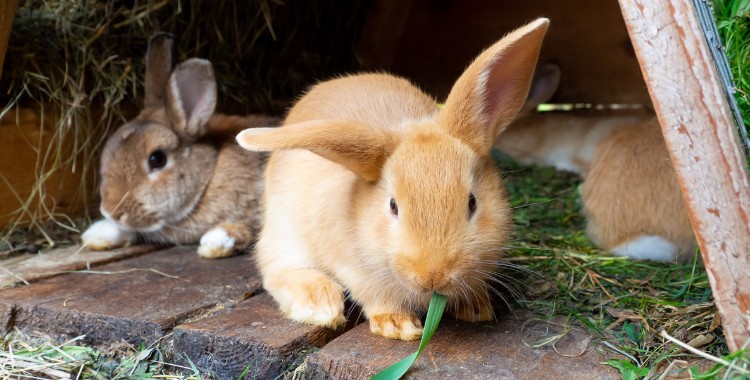Thinking about giving your pet bunny the joys of outdoor living? Many rabbit owners ponder the question, Can Pet Bunnies Live Outside? The answer is yes, they absolutely can! Providing your bunny with an outdoor life can be incredibly enriching, offering them more space to hop, explore, and engage with their natural behaviors. However, transitioning your fluffy friend to the great outdoors requires careful planning and a commitment to ensuring their safety and comfort. This comprehensive guide will walk you through everything you need to know to create a perfect outdoor haven for your pet rabbit, ensuring they thrive in their new environment.
To ensure your bunny is happy and healthy living outside, you need to create a secure and enriching environment tailored to their specific needs. Here’s how to set up the perfect outdoor home for your rabbit:
Creating a Safe Outdoor Home for Rabbits
One of the most crucial aspects of keeping rabbits outdoors is providing a spacious and secure enclosure. Rabbits are active creatures who need ample room to move around, stretch out, and express their natural behaviours.
Spacious and Secure Enclosure
A hutch should be more than just a shelter; it’s the central hub of your rabbit’s outdoor life. Ensure it’s large enough for your bunnies to comfortably stand fully upright on their hind legs, stretch out, and take at least three hops from one end to the other. This ensures they have enough space within their hutch to feel comfortable and unstressed.
Beyond the hutch, a run is essential. This should be significantly larger – ideally at least three times the size of the hutch – allowing for proper exercise and exploration. Rabbits love to run, hop, and explore, and a spacious run will cater to these needs, preventing boredom and promoting physical health. While the idea of letting your bunny roam freely in the garden might seem appealing, it’s generally not recommended. Gardens can contain a multitude of hidden dangers for rabbits, from toxic plants to potential predators.
Spacious hutch for outdoor bunnies with room to stand and hop, ensuring comfort and space for natural behaviors.
Rabbits are natural nibblers and curious explorers. Unfortunately, this can lead them to ingest plants that are toxic to rabbits. Many common garden plants pose a threat, including geraniums, daffodils, aloe, hemlock, and most plants that grow from bulbs. This list is not exhaustive, and it’s always best to err on the side of caution. If you intend to bunny-proof your garden, thorough research is essential to identify and remove all potential hazards. For a more detailed guide on poisonous plants, you can find extensive resources online and at your local vet.
Predator Protection
Rabbits are prey animals, and their natural instinct is to be constantly vigilant. Safety from predators is paramount for outdoor bunnies. The mere sight or scent of a predator can cause extreme stress, and in severe cases, rabbits can even die of fright. Domestic pets like cats and dogs, even if they are playful, can be perceived as a significant threat by a rabbit.
Consider all potential predators in your area. Does your neighbor have a cat that roams freely? Are there foxes in your locality? Birds of prey could also pose a threat, especially to smaller breeds. Ensure your rabbit’s enclosure is completely secure, with sturdy wire mesh that predators cannot break through or dig under. A covered run can offer additional protection from aerial predators and prevent escapes. It’s also wise to consider burying wire mesh around the perimeter of the run to prevent digging predators from gaining access.
Weather Protection
Rabbits are susceptible to extreme weather conditions. Providing adequate weather protection is crucial to ensure their well-being throughout the year. Their outdoor home needs to be dry, well-ventilated, and protected from drafts.
Consider installing roof panels on the hutch or using a tarpaulin to shield it from rain and snow. This will keep the living area dry and prevent damp conditions, which can lead to health issues and insect infestations. In the summer, the same roof covering will provide essential shade, protecting your bunny from direct sunlight and overheating.
Ensure the hutch is not placed directly on soil or grass. Elevating it slightly above ground level can improve ventilation and further protect it from dampness and ground-level predators. If you have an outhouse, shed, or garage that’s not in use, these can be converted into excellent rabbit homes, offering superior protection from the elements. However, ensure these spaces are free of electrical wiring and stored vehicles, as rabbits may chew on cables or inhale harmful fumes.
Company and Enrichment
Rabbits are highly social, intelligent, and inquisitive animals. They thrive on company and mental stimulation. Outdoor rabbits can sometimes receive less human interaction than indoor rabbits, making it even more important to cater to their social and enrichment needs.
Keeping more than one rabbit is highly recommended, especially for outdoor setups. A bonded pair of rabbits will provide each other with constant companionship, reducing loneliness and promoting natural social behaviors. However, always ensure rabbits are properly bonded to avoid fighting. Even with bunny companions, regular interaction with you is still essential. Spend time with your rabbits daily, offering gentle petting, talking to them, and engaging in interactive play.
To further enrich their environment, provide tunnels, huts, and hides within their enclosure. These offer shelter, security, and cozy spots for rest. Additionally, introduce items for mental enrichment and fun, such as rabbit-safe toys, hanging feeders, and foraging opportunities. Scatter hay and edible herbs around the run to encourage natural foraging behaviors, keeping them mentally stimulated and entertained.
A young rabbit exploring its outdoor environment, highlighting the importance of gradual introduction and mild weather conditions for their first outdoor experience.
Seasonal Care for Outdoor Rabbits
Rabbits are adaptable creatures, but they need your help to navigate the changing seasons. Understanding seasonal care is vital for ensuring your outdoor bunnies remain healthy and comfortable year-round.
Spring and Autumn
Spring and autumn are generally the most comfortable seasons for outdoor rabbits and often the best times to transition an indoor rabbit outside. The milder temperatures make the change less stressful and allow rabbits to acclimatize gradually. However, even during these seasons, be mindful of sudden weather changes. Spring can bring unexpected cold snaps and heavy rain, while autumn can have chilly nights. Always monitor the weather forecast and be prepared to provide extra protection if needed, such as temporary rain covers or extra bedding for colder nights.
Summer Heat
Summer heat poses a significant risk to rabbits. They are highly susceptible to heatstroke, as they lack efficient cooling mechanisms. Rabbits primarily regulate their body temperature through their ears, and this can be insufficient in extreme heat. Temperatures above 21 degrees Celsius (70 degrees Fahrenheit) can be stressful for rabbits, and anything significantly higher can become dangerous.
To help your bunny stay cool in the summer:
- Provide Shade: Ensure their hutch and run are located in a shaded area, away from direct sunlight throughout the hottest part of the day. Use tarpaulins, shade cloths, or natural shade from trees or bushes.
- Cool Surfaces: Place ceramic tiles or cooling mats in their enclosure. These provide a cool surface for rabbits to lie on and regulate their body temperature.
- Frozen Water: Offer frozen water bottles wrapped in towels or ice packs (also wrapped) for them to lean against. Be sure to wrap them to prevent direct contact which can cause frostbite.
- Ventilation: Ensure good ventilation around their hutch. A gentle breeze can help, but avoid placing them in direct drafts. Fans can be used cautiously, ensuring they are not directed straight at the rabbit and that wires are inaccessible.
- Misting/Spritzing: Gently mist their ears with cool (not cold) water or wipe their ears with a damp cloth. Evaporation will help cool them down.
- Fresh Water and Vegetables: Ensure constant access to fresh, cool water. Increase the amount of fresh, water-rich vegetables in their diet, such as leafy greens, to help with hydration.
Recognize the signs of heatstroke in rabbits: heavy panting, lethargy, drooling, wetness around the nose, hot ears, and redness inside the ears. If you suspect heatstroke, immediately move your rabbit to a cooler place, offer cool water, and contact your veterinarian immediately. Heatstroke is a medical emergency and can be fatal if not treated promptly.
Rabbits seeking shade outdoors, emphasizing the importance of providing ample shade and cooling options to protect them from summer heat.
Winter Cold
While rabbits are more tolerant of cold than heat, winter cold still requires careful management. Temperatures below 10 degrees Celsius (50 degrees Fahrenheit) can become uncomfortable for rabbits, especially older or younger ones. When temperatures drop to freezing (0 degrees Celsius or 32 degrees Fahrenheit) or below, extra precautions are necessary.
To keep your rabbit warm in winter:
- Insulated Hutch: Use a well-insulated hutch to retain heat. Hutch covers and thermal hutch wraps are commercially available and provide excellent insulation.
- Extra Bedding: Provide deep layers of bedding, such as hay or straw, for burrowing and warmth. Dust-free bedding is essential for respiratory health. Newspaper layers underneath can add extra insulation from damp ground. Avoid blankets, as rabbits might chew and ingest them.
- Wind Protection: Position the hutch to shield it from prevailing winds and rain. Use windbreaks or tarpaulins to block drafts.
- Elevated Hutch: Ensure the hutch remains elevated above the ground to avoid dampness and cold rising from the ground.
- Heat Pads (Microwavable): Microwavable heat pads designed for pets can provide supplemental warmth. Wrap them in towels and place them under bedding in the hutch, providing a safe source of heat.
- Regular Checks: Regularly check the hutch for dampness and leaks. Wet bedding can freeze and make your rabbit extremely cold and ill. Replace damp bedding immediately.
Recognize the signs of a cold rabbit: cold ears, huddled posture, reluctance to move, and fluffing up their fur to trap air. In severe cases of hypothermia, they may become lethargic and unresponsive. If you suspect your rabbit is too cold, bring them to a warmer, sheltered area and provide warmth gradually. If they are severely cold or unresponsive, seek veterinary advice immediately.
Introducing Baby Rabbits to the Outdoors
Baby rabbits, also known as kits, are more vulnerable to temperature fluctuations and environmental changes than adult rabbits. Introducing baby rabbits to the outdoors requires extra care and a gradual approach.
Gradual Introduction
There’s no single definitive age for when baby rabbits can go outside, with recommendations varying. However, the key is gradual introduction. Regardless of age, young rabbits need time to acclimatize to the outdoor environment.
Start with short, supervised sessions outdoors in a secure run or pen. Begin with just 10-15 minutes and gradually increase the time spent outside each day. Choose mild, pleasant days for initial introductions, avoiding extremes of heat or cold. Spring is often the ideal time, as temperatures are typically moderate.
Dietary Changes
If your baby rabbit has never had fresh grass before, introduce it slowly and cautiously. Some breeders recommend offering a few blades of grass indoors before their first outdoor experience. This can help prevent them from overeating grass when they are first exposed to it outdoors, which can cause digestive upset. Like any new food, introduce grass gradually to avoid tummy problems.
Moving Indoor Rabbits Outdoors
Moving an indoor rabbit outdoors requires a careful transition to minimize stress and ensure their well-being.
Gradual Transition
The best time to move an indoor rabbit outdoors is during spring, when the temperature difference between indoors and outdoors is less stark. A sudden shift from a climate-controlled indoor environment to the unpredictable outdoors can be stressful and potentially harmful.
Begin by placing their hutch outdoors for a period while they remain indoors. This allows them to become accustomed to outdoor sights, sounds, and smells gradually. Once they seem comfortable and the weather is mild, start placing them in their outdoor hutch for short periods during the day, gradually increasing the duration. Initially, bring them back indoors at night. Over a week or two, depending on the rabbit’s individual adjustment and the weather conditions, you can transition them to living outdoors full-time.
Coat Adjustment
Indoor rabbits, living in a constant temperature environment, do not develop the thick winter coat that outdoor rabbits do. This means they are less equipped to handle cold temperatures initially. When transitioning an indoor rabbit outdoors, especially as colder weather approaches, ensure they have ample extra bedding and shelter to stay warm while their coat adapts naturally over time. Similarly, their summer coat might be less dense than a rabbit born and raised outdoors, so providing shade and cooling is especially important during their first summer outside.
By following these guidelines, you can confidently answer “yes” to the question, can pet bunnies live outside? and provide a safe, happy, and enriching outdoor life for your furry companions. Remember, responsible pet ownership means understanding and meeting your rabbit’s specific needs, ensuring their well-being in every season.


